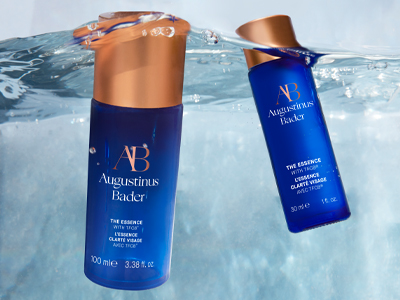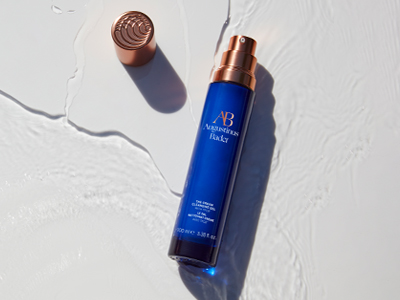Exfoliation is essential for skin that looks clean and healthy. But that radiance can turn to redness if you’re not exfoliating the right way. Learn how to exfoliate your skin without irritation so it glows.
The Quick Answer: How to Exfoliate Skin
First, you'll want to determine your skin type to know what ingredients to look for in a chemical exfoliant. You'll want to start by applying a pea-sized amount to your skin and rubbing it in a circular motion. After around 20-30 seconds, wash the exfoliant off with warm or cold water. The best way to exfoliate your skin is to use it once or twice a week before bed. Exfoliants are an add-in and not a replacement. Continue your regular skincare routine, and don't replace any nutrient-rich products with an exfoliant.
What Is Exfoliation?
Exfoliation removes the buildup of dead cells that naturally accrue on your face, and it helps remove impurities that can clog pores that lead to breakouts.
There are different types of exfoliators you can choose:
Chemical Exfoliants
- Alpha hydroxy acids (AHAs), including glycolic and lactic acids
- Beta hydroxy acids (BHAs), such as citric and salicylic acids
- Poly-hydroxy acids (PHAs), which include gluconolactone and lactobionic acids
- Fruit enzymes such as pineapple, papaya, and bromelain
Physical Exfoliants
- Scrubs containing tiny particles such as sugar or ground nutshell
- Professional microdermabrasion or dermaplaning
- Brushes (manual or automated)
- Loofahs
- Special exfoliating cloths
An important distinction between chemical and physical exfoliators: chemical products can penetrate the skin, while physical exfoliators work on the skin’s surface.
Know Your Skin Type
The best way to exfoliate skin depends in large part on your skin type. If your complexion tends to be dry, for example, you should choose an AHA exfoliant–it’s gentle and helps provide critical hydration to support your skin barrier. If you have oily skin, you may want a more potent salicylic acid-based product to keep pores unclogged.


The Most Important Steps for Skin Exfoliation
Do you want an exfoliating face scrub or a PHA lotion? How often should you exfoliate your face for optimal results? Follow our suggestions to get the most out of exfoliation
Skin Exfoliation Dos
Use a Chemical Exfoliant
Chemical exfoliators are typically gentler on your skin than something like a scrub, which can be grainy and rough. That kind of physical exfoliation may cause microscopic tears in the skin barrier, which can lead to damage. Harsher scrubs can also cause redness or irritation.
Chemical exfoliators also can be more effective at removing dead skin cells, dirt, and excess oil because they can work deeper in the skin than physical scrubs. If you want to try physical exfoliation, use a cloth designed for that purpose–a regular washcloth won’t be gentle enough.
Only Exfoliate Once or Twice a Week
Unless your exfoliator is very gentle and specially formulated for daily application, limit use to once or twice weekly to prevent irritation and redness. (A powerful cleanser can control debris buildup on the days you don’t exfoliate.) Stop using a product immediately if your skin becomes inflamed or sensitive to the touch.
Exfoliate at Bedtime
Newly uncovered skin is a clean slate for your nighttime skincare products to work to their ultimate potential. Your fresh face is also sensitive to environmental aggressors so it’s best not to exfoliate and head outdoors.
Wear Sunscreen
Your complexion needs daily protection from the free radical damage caused by UV exposure. That's particularly true for fresh, exfoliated skin, which is more vulnerable to damage and can result in wrinkles, sagginess, dark spots, and other unwelcome skin issues. Use a minimum SPF 30 sunscreen with broad-spectrum coverage.
Keep Your Skincare Routine Intact
Exfoliation doesn’t take the place of any steps in your normal skincare routine. In fact, it’s important to nourish exfoliated skin with vitamins, botanicals, and other beneficial ingredients that support a healthy complexion. Continue to cleanse, tone, and hydrate, as usual, every day.
Exfoliate Your Body
All of your skin needs an exfoliating recharge to look and feel refreshed. Apply a gentle exfoliator during your shower, or run a dry brush over your body before bathing. Pat skin dry after getting out of the shower and moisturize immediately.


Skin Exfoliation Don’ts
Don’t Exfoliate Everyday
As mentioned before, daily exfoliation isn’t necessary with most products. An effective skincare routine helps your complexion stay vibrant and balanced until it’s time to exfoliate again.
Don’t Exfoliate after a Facial
Facials are potent beauty treatments that usually include some form of exfoliation. Using a product on your own in the days after a facial can lead to irritation.
Don’t Let Skin Get Irritated
Some products, particularly certain types of chemical exfoliators such as salicylic acid, may cause a slight tingling sensation during use. But exfoliators should never cause pain, stinging, itchiness, or redness. If you experience any of those issues during exfoliation, discontinue use.
Don’t Wash Off Chemical Exfoliants
Follow instructions carefully when using any exfoliator. Many chemical products recommend leaving the exfoliant on for a short time, such as 10 to 15 minutes, so it can fully get to work.
Don’t Go in the Sun Unprotected
This can’t be stressed enough–wear sunscreen and limit UV exposure to prevent damage to your beautifully exfoliated skin. Don’t forget to apply sunscreen even if you’re indoors, because some UV rays can penetrate through windows in your home, office, or car.


Augustinus Bader Luxury Skin Exfoliation
Once you find the best way to exfoliate skin, make sure to care for it properly. Use skincare products that:
- Soothe skin after exfoliation and calm any redness.
- Hydrate and moisturize, so skin feels soft and supple.
- Cleanse your complexion thoroughly to keep it looking youthful in between exfoliation.
- Nourish and condition skin with clean ingredients and advanced skincare formulations.
Try matching these products with your favorite exfoliator. Powered by our signature TFC8® science-based technology, our facecare and bodycare products represent a true evolution in skincare:
Purchase one of our game-changing formulas in skincare, supplements and haircare.
Frequently Asked Questions About Exfoliating Skin
What is The Best Way to Exfoliate Skin?
The best way to exfoliate the skin is to utilize a chemical exfoliant formulated with ingredients that accommodate your skin type. You'll want to use it once or twice a week as part of your nighttime routine. Be mindful of how your skin reacts, and don't continue using it if your skin becomes irritated or inflamed.
Is it Better to Exfoliate Dry or Wet?
It depends on the product you're using and the ingredients. Generally, chemical exfoliants are applied to dry skin and then washed off with warm or cold water. If you're using a physical exfoliant on your body in the shower, exfoliating wet skin is much easier. You'll want to apply it to wet or damp skin for the best results.
How Often Should I Exfoliate?
You'll want to exfoliate once or twice a week as part of your daily nighttime skincare routine. This will depend on your skin type and how sensitive your skin is to the ingredients in the exfoliant. If you notice any signs of irritation, consider trying the skin cycling method or cutting it down to once a week for the best results.

